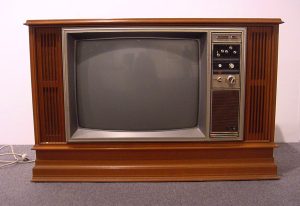19 The Lowdown on Cable Television
Shelbey Jumper
19.1 Cable Television and Generation X
Cable television (Cable TV) was an incredible invention in the late 1940s. However, it was not popular, commercialized, or brought into the average household until the 1970s and 1980s. Men, women, children, parents, cousins, and everyone else who was able to get their hands on a cable television set were amazed. Cable TV greatly influenced Generation X, whose birth years range from the mid-1960s to the early 1980s. There were now over 30 TV channels that could be watched in the home instead of around a measly 4. There were stations that played moves, broadcasted news from all over the world, and had everyone’s favorite cartoons. For most, cable TV was the start of something huge that changed daily life. The technological advancement of cable television affected Generation X in a number of different ways. Cable TV greatly influenced popular culture and increased exposure to non-age-appropriate content. Due to this technology being so easily accessible and acceptable in households, Generation X was easily influenced by what the TV was showing, and it continues to affect those of Generation X as well as the later generations.

“old tv set” by keen_seth is licensed under CC BY-NC-SA 2.0
Keywords
- The Lowdown – Slang commonly used in the 1970s meaning the basic information.
- Generation X- Those born between the mid-1960s and early 1980s.
- HBO- A television show and movie channel within cable TV that launched in 1972.
- CNN- A national news outlet that launched in 1980.
- MTV- A channel that formerly only played music videos of the most popular music that launched in 1981.
Learning Objectives
- Explain what cable television is to others.
- Express to others how cable television had a positive and negative effect on Generation X.
- Understand how the technological advancement of cable television affected the culture and lifestyle of Generation X.
- Understand why Generation X was easily influenced by cable television
19.2 What is Cable Television? Where did it Come From?
Key Takeaway
Television originally had around four TV channels, but cable television brought households anywhere from 30-80. This was created with the means of forming a new type of mass information and entertainment system. Information no longer had to be spread primarily through middlemen. Local news platforms could still be reached, but now there was a formation of national newsgroups that covered stories across the United States and around the world. This made news media more accessible, diverse, and convenient for everyone in the United States. The technological advancement of Cable TV was so appreciated and accepted that people believed it to be one of the biggest inventions in world history, comparable to the printing press. This comparison was made because of the great acceleration of the spread of information, education, ideas, and entertainment at that time.
The innovation of cable television didn’t only create a new way of spreading information, it also made new forms of entertainment which allowed the culture of those influenced to diversify. Although local news stations could be seen through local television stations and newspapers, popular music heard on the radio, and movies could be watched at the movie theater, Cable TV combined it all for a more centralized source of daily pleasures. HBO, a TV show and movie channel, launched in 1972, CNN, a national news outlet, launched in 1980, and MTV, at the time a station for music videos of the most popular music. These three forms of entertainment and information were extremely popular during the rise of Cable TV and instantly hooked their viewers because of the simplicity of accessing it and the originality of their concepts. Generation X, those born in the mid-1960s to early 1980s, was greatly influenced by everything previously mentioned. This is the generation who created a new culture for themselves, with a main factor being the technological advancement of cable TV and everything that contributed to it.
19.3 Popular Culture
Key Takeaway
Culture is a very important part of every person and can be exclusive to each generation. Generation X built a unique culture which is in part due to cable television. Generation X has and still is, very involved in their popular culture as they were the first generation to be raised on this technology. The distinctive common experience that this generation underwent during the expansion of cable TV united them in ways that are nearly impossible for other generations. Although technology was not extremely advanced at this point, cable TV was the start of significant technological growth. Generation X was molded by cable television. The influence of this gave way to their popular culture and influenced their behavior through what was shown and viewed on a daily basis.
Generation X was the very first generation to have their new type of music played on television nearly all day and all night. Pop and rap emerged during the lifetime of Generation X children and took the music world by force. When cooking, hanging out with friends, or playing pool, kids of this generation were able to listen to and watch MTV where popular music videos were constantly played. This is just one contribution to the youth culture of this time period. Some even gave this generation the nickname “the MTV generation” for the impact this had on so many people. Education/News channels also provided a lot of knowledge to Generation X and led them to have more exposure to the real world. Being able to see the Amazon Rainforest or the streets of Great Britain from your small-town living room was a truly defining moment for this generation. Learning more through leisurely watching the newfound channels guided these children to lives full of knowledge and a better understanding of the world around them.
19.4 Content on the Screen
Key Takeaway
For Generation X, cable television provided many outlets with content that was not particularly age-appropriate. This content caused children of this time to, in some ways, grow up faster. Generation X was exposed to a range of different things that influenced different behaviors in their personal lives. For example, HBO housed rated R movies that were accessible to kids who were not yet suitable for the content shown. Movies showcasing kids their age partying and drinking were very common and made it look like a normal happening. Even rock stars and singers influenced them since news channels could capture their good and bad sides for everyone, especially the children, to see and learn from. Exposure to this type of information caused children of this time to become disinclined to confront current and future challenges in the real world.
In 1986, CNN covered the space shuttle explosion, which is ingrained in many of the children of Generation X’s minds. CNN also covered the start of the first gulf war. Kids now had unrestricted access to information that was not beforehand formulated for their understanding. Generation X was more likely to be unsure of the real world due to this exposure which likely caused them to view the world in unanticipated ways. Because of these insecurities, many members of Generation X didn’t want to go into the real world where real everyday life looked like it did on the news; the stock market crashing, countries at war, unaffordable mortgages, and so much more. Positively, though, these things caused Generation X to be more adaptable to change since it is the change to cable television that they were raised with. Despite the controversial negatives that it may have caused, they still had an eternal availability of news, popular culture, education, and other entertainment at their fingertips every day, and it will continue to forever.
19.5 Influenced and Accepted
Key Takeaway
Most children of Generation X were very young when they were introduced to cable television. Because of this, they were able to adapt to the new technology in a different, more efficient way, than older members of society. Nothing was set in stone about their way of life yet, so much of it was easily alterable. This created room for new habits to quickly be developed after the introduction of cable TV, it almost seemed like there was a completely new way of life. It is clear that Generation X was unaware of how large the change was, they just absorbed the immense amount of information that came their way. These children were more comfortable with new technology and were usually more technologically savvy than others because of the common use of technology and its influence. Parents during this time were more hands-off and allowed their children to learn and experience things on their own. This idea is associated with the term latchkey kids where children were without adult supervision for an extended period of time. This created the opportunity for cable television and its content to become extremely influential and act almost as a babysitter to many kids of generation X.
Television channels and their content were so influential that they became an extremely important aspect of Generation X’s lives. CNN, MTV, HBO, and others quickly became strong influencers during this time, so whatever was shown, was most likely to be followed and accepted by Generation X. Whatever these channels said or did, made these kids increasingly likely to behave or think in similar ways. TV shows, commercials, and current news around the world are highly associated with this generation’s childhood and development. Due to the age of Generation X, the attachment to and persuasion of cable television grew as it became part of their daily lives.

“Majorc Redit Cards” by Curtis Gregory Perry is licensed under CC BY-NC-SA 2.0.
19.6 Social Habits
Key Takeaway
Accessibility to cable television made it easy to watch whatever you wanted, whenever you wanted. As we already know, since television was consistently run, it influenced Generation X and their culture. This became so popular that it became a part of Generation X’s daily lives, and their mindset seemed to alter to one that was more fit around cable television. This generation was the first to watch MTV music videos of their specific new music taste all day, see news stories from across the country, and have a channel dedicated to movies that they before, would have had to go to a movie theater to see. This created the culture that generation X bonded over, and to this day, continue to bond over and share with those of older and younger generations. This habitual viewing was the source of many, many, shared experiences that created a deep social connection between the members of Generation X. Another name for this generation was “couch potatoes” because of its strong attraction for these kids. However, some critics do say that there are positive and negative effects due to the immense influence that characterized the generation itself.
19.6.1 Positive Effects
The children of Generation X are defined as practical, independent, and resourceful. Many events went into forming this depiction, and cable television’s effect can clearly be seen. Because of the premature and overdeveloped sense of self these children had, they were able to do many things that other generations could not at the same age. Children during this time were able to skillfully act as an adult, and look at situations in a realistic way. Issues were also dealt with efficiently and effectively due to the vast amount of information provided to them and understood by them. This has caused Generation X to be cautious with their decisions and be exceptionally aware of possible consequences. Because of their early real-world experiences, they aged to become well-rounded, hopeful, and successful adults.
19.6.2 Negative Effects
In contrast, members of Generation X are commonly described as self-absorbed, told they are slackers with a short attention span, and thought to have a lack of work ethic. These characteristics can be contributed to a multitude of different events that went on within the years that make up this generation. A big explanation for this is the creation of cable television. Cable TV made it possible to spread a lot of information from far distances and in a very short period of time, which ended up prematurely creating a sense of adulthood for kids of generation X. These adult-like ideas and concepts caused stress in the lives of Generation X and drove them to become unsure of their future and miss out on the full simplicity of childhood.

“National geographic” by Stefson is licensed under CC BY-NC-ND 2.0
Cathy Robinson’s View on Cable Television
Cathy Robinson was born in 1971, making her a member of Generation X. Originally from the small town of Chapin, South Carolina, her knowledge of the world was fairly limited. She was introduced to cable television at the age of 9 and says that cable television allowed her to understand what was going on around the world easier than before. With all of the footage provided through their television screens, she was able to do things like watch Princess Diana’s wedding, which she would have only heard about before the acquisition of their cable television set. This was so impactful that she can still vividly remember the wedding. Cathay also thought it was amazing to see more than a one-hour show on something that was available on the four channels they used to have. She believes that if they didn’t invest in a cable television set that she would have missed out on a lot of educational opportunities. Cathy also displayed her concerns about this through personal experiences. She claims that her generation grew up a lot earlier because of the things they were exposed to through the emergence of cable television, such as movies on HBO that were rated R, but her parents had already subscribed to. After her parents had gone to bed, she had free range to watch whatever she wanted to, no matter the mental effect they might have had. Having access to real-world issues also had an effect on her view of the world as she grew older. Cathy reasons that she felt too young to have been frightened by issues overseas and that unreasonable domestic matters for her age. In a more positive light, Cathy explains how she wouldn’t have traded cable television for anything because of the positive effects it had on her and her generation. They were able to easily access new information and news, bond with peers over trending music, and experienced the creation of Generation X culture firsthand. Cable television opened up a world of opportunities for Generation X.
Chapter Summary
Cable television had many large and lasting effects on generation X. It enabled the spread of information across America and was one of the greatest technological developments in recent history. This brought new platforms to the stage that influenced those who were most vulnerable to being swayed, generation X. Culture, daily habits, entertainment, newsgroups, and much more diversified through the advancement of cable television. Exposure through new channels influenced this generation in both good and bad ways and became increasingly important to everyday life. Generation X was the first generation to be raised with cable TV and its technological, mental, and cultural impact lasted.
Review Questions
Food For Thought
- Look at yourself and your habits with cable television or television in general. What do you feel your relationship with it is, and how has it affected you as you have grown?
- What do you think television will be like in the future? Will it keep changing and improving? Will there still be cable television or any version of it?
- Think about people you know who are a part of Generation X. What effect did cable television have on them? Do you think that they have a strong connection with it?
References
Engelman, R. (1990). The origins of Public Access Cable Television, 1966-1972 (Vol. 123). Association for Education in Journalism and Mass Communication.
Owen, R. (1997). Gen X Tv: The brady bunch to melrose place. Syracuse University Press.
Mokhoff, N. (1980). Consumer Electronics: Intelligent Television receivers; personal computers proliferate; Cable TV expands. IEEE Spectrum, 17(1), 64–68. https://doi.org/10.1109/mspec.1980.6330228
Weispfenning, J. (2003). Cultural functions of reruns: Time, memory, and television. Journal of Communication, 53(1), 165–176. https://doi.org/10.1111/j.1460-2466.2003.tb03012.x
Podara, A., Matsiola, M., Kotsakis, R., Maniou, T. A., & Kalliris, G. (2021). Generation Z’s screen culture: Understanding younger users’ behaviour in the television streaming age – the case of post-crisis Greece. Critical Studies in Television: The International Journal of Television Studies, 16(2), 91–109. https://doi.org/10.1177/17496020211005395
Bondad-Brown, B. A., Rice, R. E., & Pearce, K. E. (2012). Influences on TV viewing and online user-shared video use: Demographics, generations, contextual age, media use, motivations, and audience activity. Journal of Broadcasting & Electronic Media, 56(4), 471–493. https://doi.org/10.1080/08838151.2012.732139
Kupperschmidt, B. R. (1998). Understanding generation X employees. JONA: The Journal of Nursing Administration, 28(12), 36–43. https://doi.org/10.1097/00005110-199812000-00012
Johnson, A. (2022, July 25). Generation X contributions that shaped our world. Generation X Contributions That Shaped Our World. Retrieved November 15, 2022, from https://extramile.thehartford.com/lifestyle/generation-x-contributions/
Those born between the mid-1960s and early 1980s.
A television show and movie channel within cable TV that launched in 1972.
A national news outlet that launched in 1980.
A channel that formerly only played music videos of the most popular music that launched in 1981.
something happening in a specific country; the opposite of foreign.

